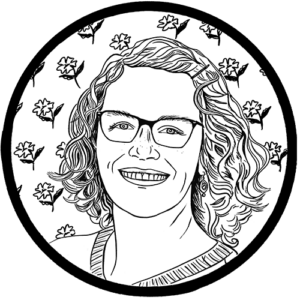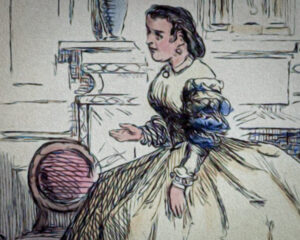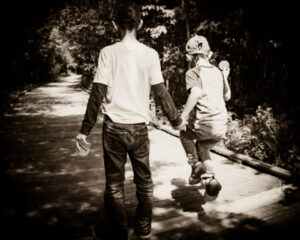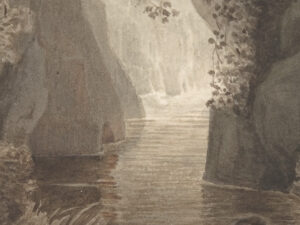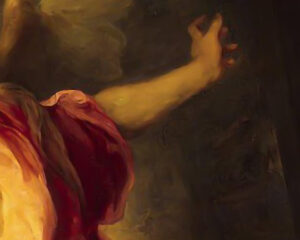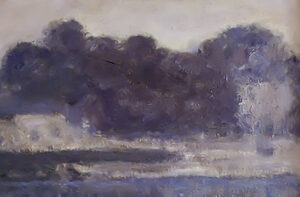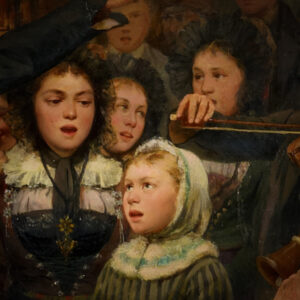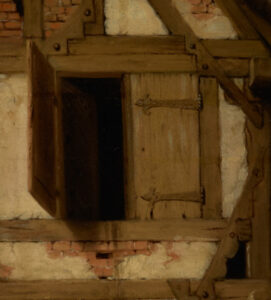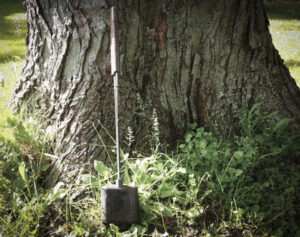When Teaching Children History,
Embrace Imagination

Dr. Dixie Dillon Lane
One day twenty-eight years ago, a redheaded eleven-year-old girl found herself standing in front of the Great Pyramid at Giza with her family.
Her mother and brother wore white turbans they had bought from a huckster at Luxor to keep off the sun. Her father wore prescription sunglasses and a baseball cap. And she — I — wore a scuffed-up pair of jeans, a long French braid, and an awful lot of sunscreen.
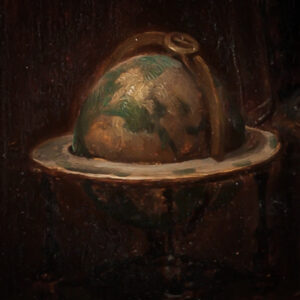 My family’s visit to Egypt had been at my brother’s request. He was fascinated by ancient civilizations and had longed to see the evidence of one of them in person. I loved history, too, as did my parents, and so although it was a strange place to spend the only Christmas of our sabbatical year abroad, my parents arranged for us to go, booking passage on a small cruise ship on the Nile.
My family’s visit to Egypt had been at my brother’s request. He was fascinated by ancient civilizations and had longed to see the evidence of one of them in person. I loved history, too, as did my parents, and so although it was a strange place to spend the only Christmas of our sabbatical year abroad, my parents arranged for us to go, booking passage on a small cruise ship on the Nile.
The entrance to the pyramid was a narrow opening framed by stone chevrons, just a hole on the side of the great monument, unassuming and rather small for its purpose. Entering, we passed almost immediately into what was not really a passage at all, but a sort of chute that, at the Pharaoh’s burial, was blocked off with three sliding blocks pushed into place by an ingenious piece of machinery. The modern entrance bypasses the three stones, but beyond them the only recent amendments to the passage are a series of wooden slats nailed to the slanting floor like a treehouse ladder and a handful of poor, unreliable electric lights. There is an occasional railing, too, but not in the tightest parts of the passage, which you must crawl through — these are perhaps four feet in height and three feet wide and as dark as, well, a tomb.
Up the chute we went. For many in our tour group full of French retirees, it was almost undoable. Sweating, crawling, clinging to the railings, we ascended slowly. Behind me, I heard one man begin to breathe heavily, and then almost to shriek. A volley of Arabic and broken English followed as the people behind the man were instructed to crawl backward out of the passage; the man was having a panic attack and needed to get out. Today, visitors are warned not to enter if they are claustrophobic.
Don’t enter unless you’re a short Ancient Egyptian slave forced to enter under pain of death would be more like it.
When I reflect back on this strange experience decades later, it has two separate meanings for me. On the one hand, I think of this arduous climb up a cramped, dark, panic-inducing shaft and am astonished that it even happened. What possessed us to attempt it? The thirst for knowledge and for experience, I suppose.
On the other hand, I look at it through the lens of my professional work as a teacher and as a historian and my personal experience as a homeschooling mother. For an arduous, panic-inducing climb is rather like what many students experience in certain types of education today — especially, I am sorry to say, in their slog through the study of history. It is, most regrettably, an excellent metaphor for some of the most deadening parts of history education in many schools and homes.
Of course, I myself find history tremendously exciting, engaging, and enlivening. Nothing is more interesting to me than history!
But while some people are instinctively drawn to history, many despise their history classes in school. Indeed, I meet adults (and even children) who hate history all the time. For example, when I recently asked a college student how her history classes were going, she replied: “Well, I’ve always thought history was boring. I always just had to memorize a bunch of facts and dates and then take tests on them, and I hated it. I never saw the point! It was just something they made me do.”
I believe that this unfortunate misunderstanding of history as boring, even pointless, is the result of a growing, well-meaning, and misguided overemphasis on memorization and detail-based education in elementary school education. This approach — what Dr. Jonathan Gregg calls hyperclassical education — favors rote learning and memorization of factoids to the exclusion of more creative, narrative aspects of pedagogy. Alarmed by the loss of knowledge and tradition in schooling in recent decades, some classical and other traditional-minded schools and home schools have, in other words, overreacted with a near-total dismissal of discussion, imagination, and question-based learning. But is it true that nothing is relative or contingent, and that all that is important about history can be learned through studying facts and “true” interpretations alone? Is it the case that we have all the answers and can simply pass them on to our children? Is that what history is?
Alarmed by the loss of knowledge and tradition in schooling in recent decades, some classical and other traditional-minded schools and home schools have, in other words, overreacted with a near-total dismissal of discussion, imagination, and question-based learning.
Let me state at once that a deep and wide knowledge base — a grounding in the facts of dates, names, places, et cetera — is crucial to the ability to understand history at the sophisticated level of an older teen or adult. And you certainly can learn the facts of history the hard way, by rote.
But learning the facts is not enough.
Let me return to the metaphor of visiting the pyramid to explain. In this metaphor, the hyperclassical approach of memorizing historical facts, repeating them on tests, and putting them all in the right slot (always making the same arguments as your teacher) is the journey upward through the tight passage. But if that is all you can see around you — a steep and claustrophobically narrow tunnel — and if you have no real understanding of where this passage is going or why, you are likely to become overwhelmed, to mentally disengage. You may, perhaps, even panic and back out.
Or, if you do make it through, as most of us in my tour group did, and most students do, what do you do at the top, at the end of your formal education? Let us return to the story and see.
After our painstaking climb and passing afterward through one slightly larger passage, there we indeed were at the top, standing with heaving chests, ready to reap the rewards of all that work. We now stood in the King’s Chamber, the very tomb of the Pharaoh Khufu, who had been laid in his sarcophagus there in the twenty-fifth century B.C. Yet, at the top of that awful climb, the tomb turned out to be, in fact . . . nothing.
A bare stone room. Plain granite walls. An empty sarcophagus.
Nothing.
But, of course, it once was something. We know that it was. But what? There at the top of the climb we were met with two options for discovering the tomb’s meaning. The first was to listen to the tour guide, who would tell us gullible and relatively wealthy Europeans whatever facts or fictions he thought would most please us and earn him “backsheesh.” He would tell us the Pharaoh’s name and the dates of his reign. We might pay attention, or we might turn to thinking about when and how (more crawling!) we would get out of here. Being told the facts might interest us some but would not necessarily lead to any understanding, or perhaps might lead to a false one.
To all the senses the place was nothing more than an empty room. Though much had happened there once, the story of it was gone, and it gave us no experience. We had little sense of its meaning. We were at the mercy of whatever that engaging, charismatic, and mercenary man before us wished to tell us.
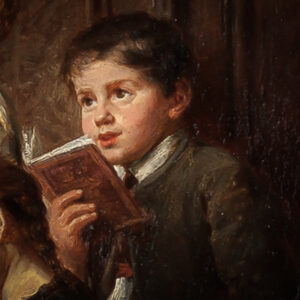 This is what a student often finds when he reaches the end of a hyperclassical, facts-only schooling, too: an empty room, with nothing but a tour guide in it to tell us whatever he wants us to hear. The student finds that he is an adult now, with the adult’s responsibility to make meaning of the world, but he can only see history as black and white. He will, when pressed, genuflect to the truisms about history’s importance, but he can’t grasp its meaning for himself, nor can he be sure when someone wishes to use it to manipulate him. And the whole thing feels fundamentally boring. He can see the walls, he can see the sarcophagus there, and he can see that it is all made of granite. But he does not know why — and the only way he can learn why is by accepting what the tour guide tells him. He does not have the skills needed either to evaluate the tour guide’s claims or to make an argument himself.
This is what a student often finds when he reaches the end of a hyperclassical, facts-only schooling, too: an empty room, with nothing but a tour guide in it to tell us whatever he wants us to hear. The student finds that he is an adult now, with the adult’s responsibility to make meaning of the world, but he can only see history as black and white. He will, when pressed, genuflect to the truisms about history’s importance, but he can’t grasp its meaning for himself, nor can he be sure when someone wishes to use it to manipulate him. And the whole thing feels fundamentally boring. He can see the walls, he can see the sarcophagus there, and he can see that it is all made of granite. But he does not know why — and the only way he can learn why is by accepting what the tour guide tells him. He does not have the skills needed either to evaluate the tour guide’s claims or to make an argument himself.
He is, in short, vulnerable.
A student like this today is like a nineteenth-century Etonian who swots over lists of the kings of England in his prep hour but then does not, at some other important and relatively frequent moment in his day or of his seasonal year, also get to play at being King Arthur.
Fortunately, most nineteenth-century Etonians did have plenty of time and opportunity to play at Arthur over their school holidays. They had a classical education and time among fairytales and in the woods at their country summer homes. But do our children today have this balance?
Now, please do let me be clear: learning about the kings of England is important to understanding European history. You cannot talk wisely about the development of Western civilization if you know nothing about this, and you are unlikely to turn into a great political leader such as Churchill who knew from history how to resist despotism. But there are two risks to thinking that learning the facts of history is enough, especially in the education of a young child.
First, it can lead to us equating fact with interpretation. We are tempted to think that there is only one way to look at history, and although we must not fall into unrestricted relativism, the reality is that interpretations are subjective. Different people can see the same fact and make different arguments. It is a fact, for example, that the United States dropped two atomic bombs on Japanese civilians in World War II. It is an interpretation that this was the cause of the end of the conflict in Japan. But we tend to say “we dropped a bomb” and “it ended the war” as if both are known facts. They are not; the latter is an argument. We may have good evidence to support the argument that it ended the war — such as the near-immediacy of Japan’s surrender — but its relative importance to that ending is up for debate, as is the question of how soon the war against Japan might have ended otherwise, the relative loss of civilian versus combatant versus overall lives that might have occurred had other means been pursued, et cetera. Indeed, Truman’s advisors had run numerous scenarios to try to predict what might have happened had other paths been taken, but even they could not know for sure.
This conflation of fact and argument is a great civic and moral danger, one that often leads to politicians convincing masses of people that argument is truth and that things unknown are known, or vice versa. So for the student who hopes one day to become a responsible voter and citizen, absorbing the facts alone is insufficient.
This conflation of fact and argument is a great civic and moral danger, one that often leads to politicians convincing masses of people that argument is truth and that things unknown are known, or vice versa.
Second, facts-only education can be very boring for many children. And while entertainment is not the point of education, part of the point is in fact to enliven the mind and, in history in particular, to awaken the kind of imagination that seeks truth rather than merely affirmation. We must not only give children knowledge, but also skill and a flexibility of mind. Facts alone are rather poor at teaching these.
For while the facts of history are fixed (although we do not know them all), the exciting truth is that we will never know exactly what happened in the past. History is mystery: it is lives and stories and pain and joy and real experience hidden behind the times. History is a matter of both fact and story.
The facts will be of little import unless we also give children the skills to interpret history responsibly. And that means broadening their imaginations: connecting children with the realities of history through play, conversation, and story so that they intuitively understand the importance of the past. If your young pseudo-Etonian memorizes a timeline but does not play at King Arthur, he will not grow up to be a great statesman, nor even the sort of citizen he really ought to be, because he will not understand what it might possibly have been like for historical (or semi-fictional, like Arthur!) people to actually be alive in their own contexts.
With a solid knowledge of historical data but a weak historical connection to real people and a poor imagination, a person can recite history but not interpret it, and so to them, history soon becomes either meaningless or dangerous.
But there is an alternative, and this is the one that I myself experienced in the empty tomb at Giza, the choice that melds facts with imagination. It was reliant not on the physical reality of the tomb or the facts recited by the tour guide, but by the way I had already been taught to think about and interpret history.
 For the girl I was at eleven years old had read The Golden Goblet, and so knew the tomb was probably empty not primarily because the contents were in a museum, but because of ancient tomb robbers. She had seen paintings of the animal-headed Egyptian gods and heard the stories of their rapacity and their inconsistent treatment of the human ka, the soul. She had seen the water plants on the shores of the Nile and read that poor children ate these once, but that the river is so polluted now as to make this impossible. She knew the stories. And by these stories she had the wherewithal to wonder if the Pharaoh had children, including girls, and what became of them. She was able to meet the challenge of these four blank walls with rich, informed, and accurate historical imagination: with facts and conceptual ability both.
For the girl I was at eleven years old had read The Golden Goblet, and so knew the tomb was probably empty not primarily because the contents were in a museum, but because of ancient tomb robbers. She had seen paintings of the animal-headed Egyptian gods and heard the stories of their rapacity and their inconsistent treatment of the human ka, the soul. She had seen the water plants on the shores of the Nile and read that poor children ate these once, but that the river is so polluted now as to make this impossible. She knew the stories. And by these stories she had the wherewithal to wonder if the Pharaoh had children, including girls, and what became of them. She was able to meet the challenge of these four blank walls with rich, informed, and accurate historical imagination: with facts and conceptual ability both.
That, I propose, is the far better path. The key to history education in the early grades is in imaginative relationship with the past. While it is good to resist pedagogical trends that ignore fact in favor of feelings, more traditionally-minded folk may need to hear a different warning: without a historical imagination, we are just as completely sunk.
Awaken the imagination and teach the facts.
But practically speaking, how can the average teacher or homeschooling parent accomplish this without becoming paralyzed or overwhelmed? How can we teach both facts and concepts? How can we both prepare the mind with facts and feed the all-important historical imagination?
Essentially, we have three choices. We can either maintain a traditional history curriculum and add on imaginative opportunities; or we can focus mainly on imaginative work and have the children do some interest-led memorization as a supplement; or — and I realize this sounds a little risky, but bear with me — we can use imagination, story, and senses alone for most or all of elementary school (beginning more formal study in high school or just before). Any one of these three approaches will set our children up for a strong formation in the knowledge and the nature and uses of history.
One good way to bump up the imaginative and conceptual side of a history curriculum is to immerse children in historical narratives. Parents can either center in on learning history through story or can easily add it via a literature curriculum or family read-aloud. Children especially love learning about other children, so harness this inclination with compelling children’s historical novels like Caddie Woodlawn, The True Confessions of Charlotte Doyle, The Winged Watchman, The Sign of the Beaver, and By the Great Horn Spoon! (and, of course, The Golden Goblet), as well as literature that was written in the past, such as The Secret Garden and Huckleberry Finn. (Meanwhile, do yourself a favor and read Shadows on the Rock, Hannah Fowler, and Killer Angels in your own spare time.)
Real stories are even more exciting and effective. Learn and tell your children orally the stories of your own family and of senior citizens of your acquaintance. Use non-fiction narrative resources such as Jim Weiss’s audio recordings; curricula like The Story of the World (I recommend volumes I and II; you may wish to preview the later volumes before using); and biographies and visual encyclopedias written for children. Author Nathan Hale’s whimsical but unsparing graphic novels about historical figures and events are sure to be hits, as are the engaging “You Choose” adventure history books.
All this can be done in conjunction with learning “divorced, beheaded, died; divorced, beheaded, survived” and other such memorization techniques, if that is important to your educational philosophy. (And children do love little ditties like this, and benefit from learning to memorize, whether in history or in another subject.)
Another helpful approach is to let local history, artifacts, and even the internet do some of the work for you. Even if you are emphasizing a place or period other than the United States this year, be sure to do the occasional deep dive into American and local history via field trip or project. The reason is that nothing connects children to the past like seeing photographs in their own town museum, and nothing better prepares them for their civic future in their local community and country. Use the internet (if you like) and local historical societies and museums to expose your children to music and art from the past, as well as objects and original letters and diaries. Show them real seventeenth-century bullets. Show them the small uniform of a nineteenth-century drummer boy in the local museum. Bake hard-tack; one bite of that tasteless rock-bread, even freshly-made, will bring the reality of soldierly and seamanly privation crashing down on them in two seconds flat like no amount of memorization ever will. Never fear — the play that results will not lead to inaccurate understandings of the facts, even if it gets a little wild. Children are deeply concerned with feeding their imaginations truth. You will be informing their imaginations with real, responsible historical encounters so that they can come to understand human nature through the past.
Bake them hard-tack, and soon you’ll find yourself visiting eight separate American battlefields in a single year with your history-hungry sons, who will learn more of the names and dates of American history in those eight visits than you ever did in thirteen years of schooling plus college, as happened to a friend of mine with her boys. For if your child’s historical imagination is alive and fed, he or she will devour the facts along the way, and will even seek them out independently. She may request an 1864 birthday party, as my eleven-year-old did, complete with a neighborhood adventure in which she and her friends had to decide whether or not to give up the location of a runaway enslaved girl, and a period-appropriate dinner, and dessert made in a hand-crank ice cream machine. (And then, like me, you’ll end up with a hand-crank ice cream machine in perpetuity! It’s a win-win.)
But you don’t have to throw parties or spend money or travel. You don’t have to take them to Egypt or Pompeii, or let them sit in the colored light at the back of Paris’ medieval Sainte-Chapelle. You can just do a little bit of all of this kind of thing, yet reap great rewards by awakening the imagination to the meaning of all these facts and artifacts. You can just take the kids to the local cemetery one day and ask them if they recognize any of the names on the headstones from street signs and business names around town. You can buy them a Civil War kepi or two (and bake that hard-tack). You can take them to the local history room in your library. You can go to the historical society and ask for a tour. They may even get to touch something that a child born two hundred years ago touched. You can make up a historical persona and write your children a letter in that person’s voice, and the kids can make up their own personas and write you back.
You can play with historical dolls. You can watch movies and do read-alouds. You can follow the kids’ interests and follow their lead. You can let them put on plays set in past eras. You can leave them with Grandpa for an hour and tell him to give them a Clark bar and tell them about buying the same candy at the five-and-dime when he was a kid. Better yet, have them interview Grandpa before they get the candy!
You don’t have to do everything. You just need to do something, with deliberate care, to emphasize both detail and imagination. Because boys and girls do not just need to learn the facts: they need to understand them. And in order to understand them, they need to play.
Such experiences establish the life trajectory of a child who becomes a historically literate adult. The alternative is a child who reaches adulthood with lots of names and dates under her belt but no understanding of the reality of history, of the fact that these people actually lived. She does not understand that people of the past once wept and slept between sheets and loved their children and used spoons. That maybe they smelled worse than we do, but they all smelled that bad, so nobody noticed. That they were just like her — but that they were also entirely different. She misses all of that. Moreover, now that she is done, she is annoyed with the climb, even though she felt she had to take it. Her only choices now are to swallow whole whatever the tour guide — or politician, or influencer, or bestseller, or lobbyist — tells her it all means, or to reject the whole thing out of hand, for she has no personal skills to use to interpret it herself.
That child possesses the walls, but the room is empty, and she can make nothing of it when she one day stops studying and begins her social, civic, and family duties. Even though she may have achieved what educators call “mastery” of the history, it is useless to her. She lacks historical wisdom and becomes easily manipulated.
That child possesses the walls, but the room is empty, and she can make nothing of it when she one day stops studying and begins her social, civic, and family duties.
It is the combination of factual knowledge and a personal, imaginative connection with history that provides our protection against history’s misuses. So while we must ignore the lie that history is entirely constructed, we must also remember to stand humbly before it and not believe that, because we have memorized the date that such-and-such happened, we understand it better than anyone else.
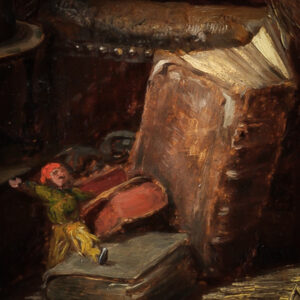 When we are exposed to this combination of imagination, story, and fact, we are better prepared to understand history, as my story of the pyramid suggests. And I am happy to report that my other story, the one about my college student friend who found the facts of history boring, had a happy result as well, once story entered the picture.
When we are exposed to this combination of imagination, story, and fact, we are better prepared to understand history, as my story of the pyramid suggests. And I am happy to report that my other story, the one about my college student friend who found the facts of history boring, had a happy result as well, once story entered the picture.
After sharing with me her complaints about her former hyperclassical history education, my friend paused to take a breath, and then she continued with what she really wanted to tell me, about her new experience of history at our local Catholic college: “But I am really starting to love history now! In class, we are reading the first autobiography ever written by a woman, and it is so fascinating! She was a mystic and talks about her experience of visions, and it’s really making me think about my own approach to popular claims of mysticism . . .”
“That’s wonderful! Did she write the manuscript by hand herself?” I asked, suspecting that this woman would have been illiterate.
“No, she dictated it to a priest.” Ah, I thought: there is a hidden interpreter! I pointed out that there were two authors of the autobiography, then, and asked my student friend how she thought that might have affected the narrative. A fabulous, winding, illuminating discussion ensued.
And why did it ensue? Because of a real historical person (actually two real persons), a question, and a story.
Over time, students exposed to history in an engaged and imaginative way will thus refine their ability to understand how a person in the past can be both like and unlike themselves. This prepares them to apply the same principles to people they meet in the present day, to understand that they can remain strongly themselves and yet appreciate and connect with, rather than feel threatened by, someone who is different from them. They will learn how to meet a confusing situation or enter an unknown context and be able to hold the familiar and the unfamiliar in tension. When they are adults, they will neither be alienated by difference nor will they cleave to it. They will not panic, they will not be gullible, and they will not flee. They will be grown.
Our children need to know the factual nuts and bolts of history before they reach adult levels of interpretation. But they also need to develop a conceptual sense of history to go hand-in-hand with this classical foundation so that when they engage with historical facts and arguments as they grow older, they will have the ability to make something of them rather than just swallow them whole at the hands of a manipulator. Neither facts nor imagination alone can lead to the kind of maturity that our kids will one day need to exhibit in both the private and the public spheres of modern life.
One day our children will have to walk difficult paths, perhaps as difficult as the passage at Giza. They will have to live through their fair share of hard times. If we engage them now with stories and help them build relationships with the people of the past, their imaginations will be prepared to apply millennia of wisdom to their own situations. And with the people of the past behind them, even in difficulty, they will not find themselves alone.



